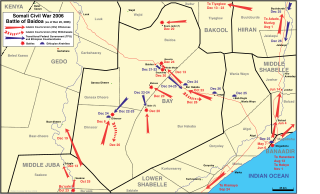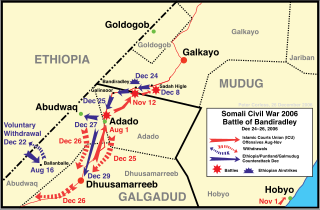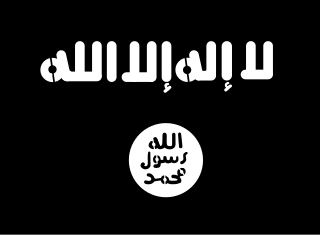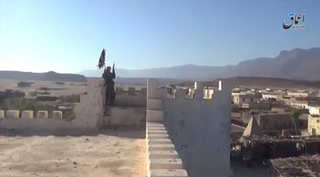
The 2006 Islamic Courts Union offensive is the period in the Somali Civil War that began in May 2006 with the Islamic Courts Union's (ICU) conquest of Mogadishu from the Alliance for the Restoration of Peace and Counter-Terrorism (ARPCT) and continued with further ICU expansion in the country. Following the outbreak of the war on December 21, 2006; by December 24, direct Ethiopian intervention in the conflict in support of the Transitional Federal Government (TFG) was no longer denied by the Ethiopian government. The Eritrean government denied any involvement despite Ethiopian claims to the contrary.

The Battle of Baidoa began on 20 December 2006 when the Somali transitional federal government forces (TFG) allied with Ethiopian forces stationed there attacked advancing Islamic Courts Union (ICU) forces along with 500 alleged Eritrean troops and mujahideen arrayed against them.

The Battle of Bandiradley in Somalia began on December 23, 2006, when Galmudug and Ethiopian forces, along with faction leader Abdi Qeybdid, fought Islamic Courts Union (ICU) militants defending Bandiradley. The fighting pushed the Islamists out of Bandiradley and over the border south into Adado district, Galgadud region, by December 25.

Harakat al-Shabaab al-Mujahideen, commonly known as al-Shabaab, is a transnational Salafi Jihadist military and political organization based in Somalia and active elsewhere in East Africa. It is actively involved in the ongoing Somali Civil War and incorporates elements of Somali nationalism into its Islamist cause. Allied to the militant pan-Islamist organization al-Qaeda since 2012, it has also forged ties with al-Qaeda in the Islamic Maghreb, and al-Qaeda in the Arabian Peninsula.

Operation Enduring Freedom – Horn of Africa (OEF-HOA) is a component of Operation Enduring Freedom (OEF). The Combined Joint Task Force – Horn of Africa (CJTF-HOA) is the primary military component assigned to accomplish the objectives of the mission. The naval components are the multinational Combined Task Force 150 (CTF-150) and Combined Task Force 151 (CTF-151) which operates under the direction of the United States Fifth Fleet. Both of these organizations have been historically part of United States Central Command. In February 2007, United States President George W. Bush announced the establishment of the United States Africa Command which took over all of the area of operations of CJTF-HOA in October 2008.
The timeline of events in the War in Somalia during 2006 is set out below.

The timeline of events in the War in Somalia during 2007 is set out below.

The 2009 timeline of events in the Somalia War (2006–2009) during January 2009 is set out below. From the beginning of February the timeline of events in the Somali Civil War (2009–present) is set out following the conclusion of the previous phase of the civil war.

The Somali Civil War (2009–present) is the ongoing phase of the Somali Civil War which is concentrated in southern and central Somalia. It began in late January 2009 with the present conflict mainly between the forces of the Federal Government of Somalia assisted by African Union peacekeeping troops and al-Shabaab militants who pledged allegiance to al-Qaeda during 2012.

This is a 2011 timeline of events in the Somali Civil War (2009–present).

This is a 2012 timeline of events in the Somali Civil War (2009–present).

The Puntland Maritime Police Force (PMPF) is a security force based in Puntland, an autonomous region in northeastern Somalia. As of May 2024, the PMPF had around 4800 personnel. The force is eventually expected to comprise 10,000 personnel.

This is a 2015 timeline of events in the Somali Civil War (2009–present).

The Islamic State – Somalia Province or Abnaa ul-Calipha is an Islamic State affiliate that primarily operates in the mountainous areas of Puntland, and which has also claimed responsibility for several terrorist attacks throughout the rest of Somalia. The group first appeared in the latter half of 2015 when pro-Islamic State fighters within Al-Shabaab defected and pledged allegiance to ISIS caliph Abu Bakr al-Baghdadi. Led by Sheikh Abdul Qadir Mumin, the group has an estimated 500-700 fighters.

The Qandala campaign began when the Islamic State in Somalia (ISS) attacked and captured the town of Qandala in Bari, Puntland, Somalia on 26 October 2016. This takeover resulted in the displacement of over 25,700 civilians and an eventual counter-offensive by the Puntland Security Force, which succeeded in driving ISS from Qandala on 7 December, and thereafter government units continued to attack the militants' hideouts in the nearby mountains until 18 December. The fall of Qandala was the second time that an Islamic State of Iraq and the Levant (ISIL)-affiliated group had captured a town in Somalia, but whereas the first takeover had lasted only for a very short time, ISS had managed to hold Qandala, a town of both major strategic as well as symbolic importance, for over a month.

The Battle of Af Urur took place on 8 June 2017, when al-Shabaab militants attacked and overran the military base and village of Af Urur in Puntland, killing many soldiers of the Puntland Security Force. It was the deadliest terrorist attack of any militant group in Puntland since the autonomous state's foundation in 1998.

This is a 2016 timeline of events in the Somali Civil War (2009–present).

Since the early 2000s, the United States has provided military support to the Transitional Federal Government and the Federal Government of Somalia in conflicts. U.S. military actions in Somalia date back to the 1990s; however, following the September 11th attacks, military action was justified as counterterrorism. The Obama and Trump administrations conducted drone and fighter aircraft strikes, advisory missions, and training; provided intelligence; and attacked al-Shabaab militants. Two U.S. special operations personnel, two contractors, one US Army soldier, and a CIA paramilitary officer have died during operations in Somalia.
Events in the year 2023 in Somalia.
The Islamic State insurgency in Puntland started on 22 October 2015 after former al-Shabaab jihadist Abdul Qadir Mumin pledged allegiance to Abu Bakr al-Baghdadi and the Islamic State, creating the "Islamic State in Somalia" and settling in the Galgala region, in Puntland.
















